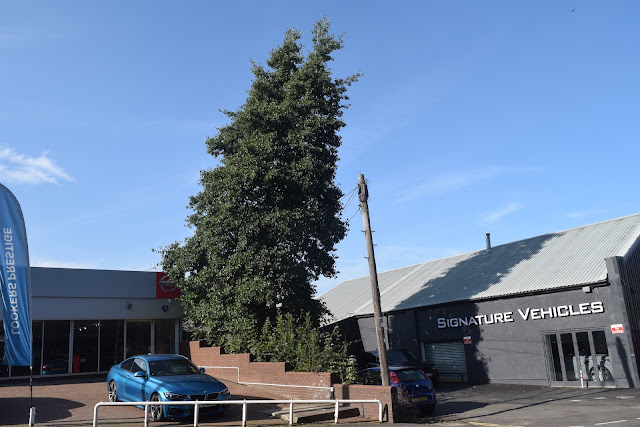More trees are cut down to make way for cycle lanes around 'Battlefield', that increasingly important 'green lung' in Shieldfield better known as the City Stadium.
Lidl's GB Limited have secured a site off Portland Road next to the new student 'Portland Green' developments. I welcome this. The site was formerly occupied by a company that sold motorhomes and latterly was used as a secure area for storing materials and parking constructor's machinery; it has been a cleared space for some while. It helps I like Lidl's.
So imagine my shock and disappointment when I saw this:
A semi mature cherry tree mutilated just as it came into full flower! It stands besides the pavement and is outside the Lidl's stores footprint as presented in a widely circulated document prior to planning approval.
Why indeed! Someone else was moved by this spectacle.
I e-mailed my three local ward councillors and copied in Lidl's GB public relations:
'Dear Councillors,
LIDL UK's NEW STORE ON PORTLAND ROAD NE2I welcomed the plans to construct a new Lidl’s store on Portland Road Newcastle in a public consultation last year; our local community has grown rapidly through student housing in recent years. That together with the impacts of necessary restrictions on retail shopping under Covid regulations have underlined isolation for many from suitably close at hand affordable and product diverse shopping in the ward as you will readily appreciate. My concern is however the unnecessary and complete destruction of trees adjacent to the planned development.Several trees outside the site's surviving inherited fencing, particularly two semi mature miniature cherry trees have been cut down to stumps. One has had an impromptu ‘Why’ inscribed on the cut area of a branch. I ask the same question. These trees added something special to a street not over blessed in flowering plants and these were in full blossom at the time of their destruction. As you will recall this location was previously used by the companies developing the student housing blocks and was already an open space for the parking and security of large plant, building materials and associated vehicles over night for the duration of the works. I would suggest an area of greater than ninety per cent of this site on Portland Road is in fact, already levelled and clear. The trees on the periphery promised no interference in the forthcoming plans as published; the proposed vehicular access point to the planned store was not Portland Road but the side street leading into the Portland Green development; safer and logical planning in respect to the site layout. Therefore the destruction of these trees seems spurious to the conduct of operations. If so, why so?The close by Warwick Street City Stadium open space has, due to imaginative care, become a very important green space and a developing site for recreation and ecological enjoyment. It is certain those of us who saw them will never again see spring coming to our corner of the city in such dazzling and welcome form again. The chance to unify both commerce, recreation and environmental development has been set back by some distance even if remedied in due course; for this writer in his eighth decade of life, for good.I hope you, together with Lidl UK, can explain what the reasons for this over enthusiastic use of chain saws amounts to, beyond casual unthinking destruction.sincerely ..'I received no response from any Councillor. Finally, I did receive a reply from a senior member of the Lidl's GB team.
'Hi (names with held)
Thanks for the email which our press office passed on to me.
Lidl’s ownership includes the strip of land from the old fencing up to the back of the existing footpath which includes the trees in your photos. In 2009 when the Portland Green development was originally granted planning consent, this strip of land was to be dedicated to the Newcastle City Council (NCC) to allow the widening of this section of Stoddart Street to two lanes in the south bound direction. NCC have now proposed a new cycle lane to replace the road widening, this is shown on our proposed site plan attached. The strip of land will be dedicated to NCC to allow these works to be completed.
The trees in your photos were located on land where the new footpath will be located, adjacent to the new cycle lane, the trees would have had to be removed by the Council in any event as they will likely complete these works. The trees that were removed are shown on the plan by 4 red circles and were done so at this stage to prevent birds from nesting which could have preventing the development progressing.
We are proposing to plant 24 new trees as part of the development, 17 on site and 7 to the north in the park. 7 of the trees on site will be located along the western boundary where the cherry trees were located.
The main roof of the store will be covered in solar panels to generate up to 1/3 of the store’s annual electricity requirements, we do not use gas to heat the store, all heat is recovered from the refrigeration system and air source heat pump.
We are also proposing a green roof on the areas not covered by the PVs principally the front and side canopy.
If you have any more questions please do not hesitate to contact me.
Regards ... (name with held)' – (Emphasis added by BftB)
This then is the second time well grown trees have been removed to benefit cyclists in an around Shieldfield. The cycle track over Battlefield required many to be removed for reasons that were not entirely apparent. This is concerning since the cycle path seemingly opens potential clashes with pedestrians. Where the cycle path goes after it reaches the junction of Portland Road and Shieldfield Lane is also moot.
Thanks to Lidl GB and Rachel Locke of Save Newcastle Wildlife.













